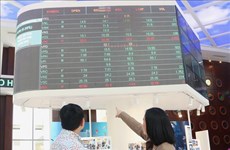Stockpiling helps boost rice farmers' profits
A Government programme to create a temporary stockpile of 1 million
tonnes of rice from the winter-spring crop has ensured that many farmers
in the Mekong River Delta earned profits, a meeting heard on June 11 in
Long An province.
A Government programme to create a temporary stockpile of 1 million
tonnes of rice from the winter-spring crop has ensured that many farmers
in the Mekong River Delta earned profits, a meeting heard on June 11 in
Long An province.
To prevent prices from falling during the peak rice harvest season, the Government tasked food companies with buying 1 million tonnes starting on March 15, fully subsidising loan interest for more than half of their loans' six-month tenure.
Vo Thanh Do, deputy head of the Agro-Forestry and Fisheries Processing and Salt Industry Department, said by April 30 companies had bought 995,494 tonnes.
He said that in early March, when the winter-spring rice crop reached the peak harvest season, prices had slumped, but thanks to the stockpile programme, paddy prices have gone up by 100-200 VND per kilogramme, enabling farmers to enjoy profits of at least 30 percent.
"Based on the average production cost of the winter - spring crop estimated by the Ministry of Finance, the difference between the cost and purchase price ranged from 35.3 to 40.6 percent."
However, Do, as well as many other delegates at the meeting, agreed that relevant ministries and agencies, local authorities, and companies need to develop closer cooperation to improve the programme's efficacy.
They also agreed that temporary inventories are merely a short-term measure, and in the long run the country must create incentives for rice export and consumption.
But Deputy Minister of Agriculture and Rural Development Vu Van Tam said that in the short term, there is no better measure to ensure profits for farmers.
The ministry is implementing a series of long-term programmes, including restructuring the agricultural sector with a focus on shifting to other food crops on low-yield rice fields and creating links between rice businesses and farmers, he said.
Replying to a question about whether the Government would adopt the programme also for the summer-autumn crop, Tam said his ministry would keep a close eye on the market, and would urge the Government to do so if prices fall during harvest.
The harvest of the summer-spring crop has just begun, and prices are stable, he said.
Nevertheless, he urged the Vietnam Food Association and localities to be prepared so that they can start to buy immediately if the Government decides to go ahead.
Nguyen Phu Hoa, deputy head of the Import-Export Department, called on food companies to strengthen links between rice production and consumption and expand trade promotions in both traditional and new markets, especially difficult markets like the US, the Republic of Korea, Iraq, and Japan.
Pham Van Bay, Deputy Chairman of the Vietnam Food Association, said the country exported about 2.3 million tonnes of rice in the first five months of the year, down 16 percent year-on-year.
The Ministry of Industry and Trade, the association, and businesses have organised and would continue to organise business trips to market rice, he said, adding that exports to Mexico and the Republic of Korea have shown positive signs recently.
Vietnam's rice exports hit 585,500 tonnes worth 248.7 million USD last month, the highest volume in the past nine months, thanks to a rising demand from Chinese importers.
According to data from the Vietnam Food Association (VFA), in May, the Asian market - including China - was Vietnam's largest rice importer, accounting for 398,200 tonnes, or 68 percent of total volume.
African and American markets followed with imports of 87,300 and 78,200 tonnes, respectively.
With May's results, the country shipped 2.34 million tonnes of rice in the first five months this year worth 1.07 billion USD.
The VFA estimated that Vietnamese rice exporters will ship roughly 6.2 million tonnes of rice this year, compared to the forecast of 6.5 to 7 million at the beginning of the year due to loss of some traditional markets in Africa to Thai traders, who have sold rice at cut-rate prices to clean up their stockpiles.-VNA
To prevent prices from falling during the peak rice harvest season, the Government tasked food companies with buying 1 million tonnes starting on March 15, fully subsidising loan interest for more than half of their loans' six-month tenure.
Vo Thanh Do, deputy head of the Agro-Forestry and Fisheries Processing and Salt Industry Department, said by April 30 companies had bought 995,494 tonnes.
He said that in early March, when the winter-spring rice crop reached the peak harvest season, prices had slumped, but thanks to the stockpile programme, paddy prices have gone up by 100-200 VND per kilogramme, enabling farmers to enjoy profits of at least 30 percent.
"Based on the average production cost of the winter - spring crop estimated by the Ministry of Finance, the difference between the cost and purchase price ranged from 35.3 to 40.6 percent."
However, Do, as well as many other delegates at the meeting, agreed that relevant ministries and agencies, local authorities, and companies need to develop closer cooperation to improve the programme's efficacy.
They also agreed that temporary inventories are merely a short-term measure, and in the long run the country must create incentives for rice export and consumption.
But Deputy Minister of Agriculture and Rural Development Vu Van Tam said that in the short term, there is no better measure to ensure profits for farmers.
The ministry is implementing a series of long-term programmes, including restructuring the agricultural sector with a focus on shifting to other food crops on low-yield rice fields and creating links between rice businesses and farmers, he said.
Replying to a question about whether the Government would adopt the programme also for the summer-autumn crop, Tam said his ministry would keep a close eye on the market, and would urge the Government to do so if prices fall during harvest.
The harvest of the summer-spring crop has just begun, and prices are stable, he said.
Nevertheless, he urged the Vietnam Food Association and localities to be prepared so that they can start to buy immediately if the Government decides to go ahead.
Nguyen Phu Hoa, deputy head of the Import-Export Department, called on food companies to strengthen links between rice production and consumption and expand trade promotions in both traditional and new markets, especially difficult markets like the US, the Republic of Korea, Iraq, and Japan.
Pham Van Bay, Deputy Chairman of the Vietnam Food Association, said the country exported about 2.3 million tonnes of rice in the first five months of the year, down 16 percent year-on-year.
The Ministry of Industry and Trade, the association, and businesses have organised and would continue to organise business trips to market rice, he said, adding that exports to Mexico and the Republic of Korea have shown positive signs recently.
Vietnam's rice exports hit 585,500 tonnes worth 248.7 million USD last month, the highest volume in the past nine months, thanks to a rising demand from Chinese importers.
According to data from the Vietnam Food Association (VFA), in May, the Asian market - including China - was Vietnam's largest rice importer, accounting for 398,200 tonnes, or 68 percent of total volume.
African and American markets followed with imports of 87,300 and 78,200 tonnes, respectively.
With May's results, the country shipped 2.34 million tonnes of rice in the first five months this year worth 1.07 billion USD.
The VFA estimated that Vietnamese rice exporters will ship roughly 6.2 million tonnes of rice this year, compared to the forecast of 6.5 to 7 million at the beginning of the year due to loss of some traditional markets in Africa to Thai traders, who have sold rice at cut-rate prices to clean up their stockpiles.-VNA













